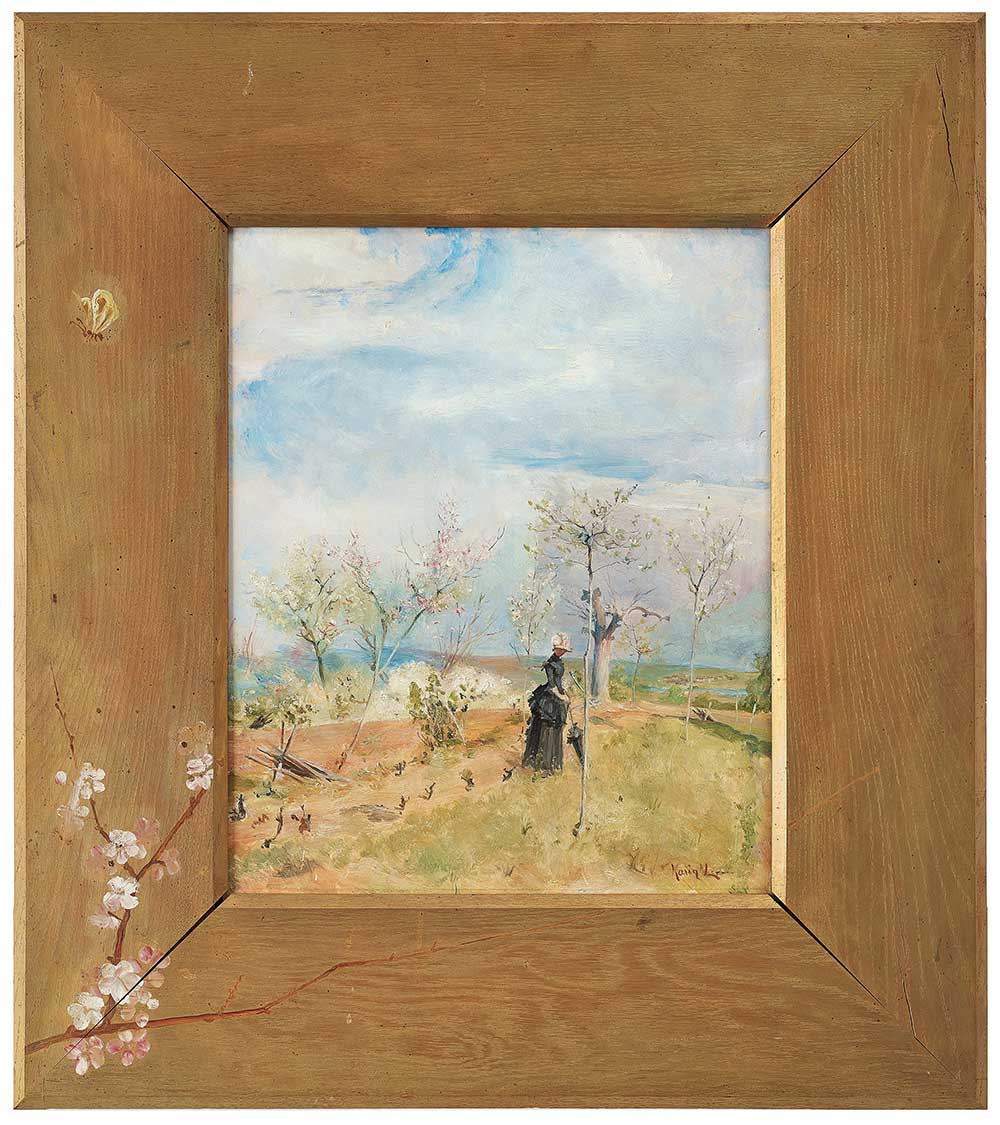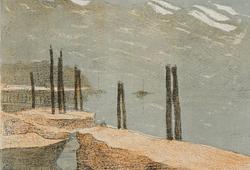Important Spring Sale presents "Cherryblossoms" by Karin Larsson
Karin Larsson Cherry Blossom
Karin Bergöö arrived in Grez on the first of July 1882 together with Julia Beck, Lydia Wigert, Emma Löwstedt and Hildegard Theorell. In Karin's letter home to her parents, the reader gets a glimpse of her work in Grez: "In Paris, I went out too much, here I have my work, and although I haven't had time to get so many results due to the weather, I have received appreciation for the little I have done"(7/14/1882).
Carl Larsson was a central figure in the Scandinavian artists' colony in Grez. Consequently, his name appears more and more often in Karin's letter home to Sweden. That Carl noticed the delightful Karin is evident from his report in "Palettskrap" (The Academy of Fine Arts' student magazine), autumn 1882:
"One of the bright moments of our gatherings was a costume ball in hotel Chevillon. Then the big thing happened. The most important turn, now Karin entered! [… ] I was finally in love in the RIGHT way. I wanted to marry her, form a nest with her to create a family. As pathetic as I seemed to myself, this was a heartbreaking thought. […] Still, Karin put her arm in mine, her little finger touched my hand, and I broke out: How I love you! This was when we crossed the bridge in Grez; we came from the neighbouring village, Montcourt, where I had invited all pensioners on grapes. She said nothing. But she LOOKED at me. No more was needed. We wrote home, and a week later came answers from her parents; it said: 'We trust Karin's judgement. We think she can only love one honourable man.' And then the first kiss happened!"
The newly engaged now started working together. In a letter to her parents, Karin writes: "After we have taken a walk, Carl goes and work, and he will always find that his motif would also be suitable for me to paint and so we work together"*. (12.10.1882)

Ingrid Andersson touches on this in "Karin Larsson. Artist and artist's wife" (1986): "From this time there are several works by Carl and Karin where they have just started on the same motif. In the spirit of outdoor painting, they took their motifs from the immediate surroundings. They have each painted their "Mére Morot" watching the harvest of pumpkins. A comparison shows that the two watercolours are structured similarly. Carl Larsson let his "Mére Morot" walk out of the picture. In the background, a high wall and ceilings of some nearby houses are visible. Like bright red balls, the pumpkins shows here and there through the crop on the ground. Karin's woman is turned away from the viewer. She walks, as in Carl Larsson's picture, with her head down and watches her harvest. Her dress is simple, with a white headscarf wrapped around her hair and an empty basket on her arm. In the background, a landscape is visible. Karin used a soft brush guide where the details can only be guessed. The watercolour is an excellent example of her colour painting, where she primarily wanted to capture a feeling and convey an experience. Less pictorial in terms of character is Carl Larsson's painting. His absolute eye for detail is nicely balanced in the picture. The paintings have great stylistic similarities in addition to the motifs. Yet they look so different."
The approach seems to have brought mutual stimulation and brought them both forward artistically. The renewed power with which Carl resumed watercolour painting from the summer of 1882 would, a couple of years later, lead to great successes. At the prestigious Salon in Paris in 1884, he sold the watercolour "Dammen" to the French state.
For Karin, art developed in Paris. Although Carl remained in Grez, she chose to spend the winter and spring in the French capital. The time was devoted, in addition to lessons in French, to further artistic studies. The studies took place primarily at the Académie Colarossi and through lessons for the accomplished Belgian artist Alfred Stevens who, during the years 1880-1890, ran a painting studio in Montmartre, mainly for female students: "Today I have been praised by Stevens for my painting, he said that my model was the best of all those who painted "(letter to parents 8.3.1883).
After a visit to Sweden, with marriage in Adolf Fredrik's Church (June 12, 1883), the couple returned, via Paris, to Grez. Although Karin's life situation, as a newlywed mother, in future gave less and less room for further development in easel painting, the few preserved paintings from this period show technical skill and, unequivocally, artistic promise.
During the spring of 1884, the couple Larsson, once again, picked up their painting materials, side by side on a beautiful and sun-drenched hill at Grez. This time the task was not about depicting a hard-working farmer's wife in an autumnal vegetable field. The motif consisted instead of an elegantly equipped young woman with a parasol surrounded by sheer cherry blossoms under blue skies. Although the spring of 1884 has been described as a period of outstanding development for Carl Larsson as a watercolourist, it is difficult not to feel that Karin's version of the motif is the winning one when comparing. It is obvious that her painting had undergone a tremendous development since her portrayal of Mére Morot in 1882.
Just over a year later, in May 1885, Carl and Karin Larsson, together with their children, left Grez and moved to Stockholm. Later on, after moving to Lilla Hyttnäs in Sundborn in 1901, Karin's art passed into the phase that created her international fame. From now on, she devoted herself primarily to what is nowadays called design and interior architecture. In addition to pioneering clothing for herself and the children, Karin created unique modern interior textiles, designed a slightly functional rocking chair and coloured and decorated the distinctive and legendary family and artist home, which attracts interest from art historians and tourists around the world. A highly significant memory from her previous activities as an outdoor painter is the auction's oil painting, which is still mounted in the original frame, decorated by Karin, from the composition's creation 137 years ago.
The painting should have served as a significant memory for Karin herself. According to Karin, the time in Grez was the happiest in her life. A few years after the creation of the painting, when Carl was alone in Grez, in the spring of 1886, she wrote: "... you are in Grez, the most glorious loveliest place on earth! I have spent so many happy moments there, from the day you first the time said that you love me. Everything around me was suddenly filled with jubilant life and happiness. The sun shone warmer, the grass smelled, and the birds sang as they had never done before."
When is the viewing and auction?
Viewing 27 May – 1 June, Berzelii Park 1, Stockholm.
Auction 2 – 4 June, Arsenalsgatan 2, Stockholm.
For more information Contact specialist

Tukholma
Björn Extergren
Johtava asiantuntija sisäänjättö ja myynti. Asiantuntija antiikkikalusteet, taidekäsityö ja aasialainen keramiikka
+46 (0)706 40 28 61



























